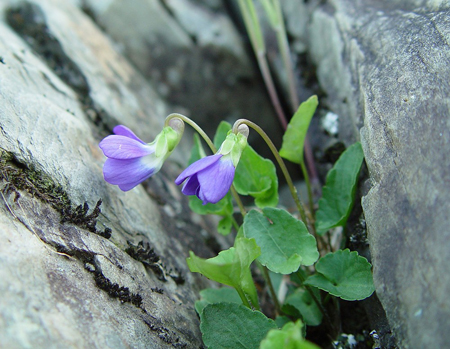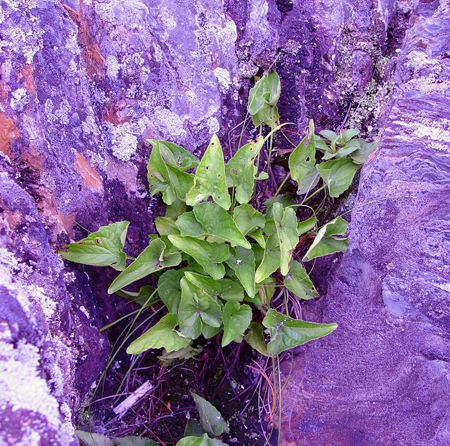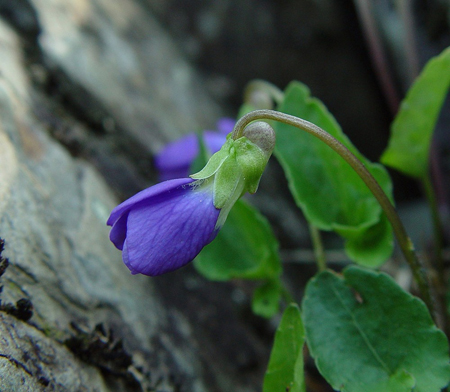Viola novae-angliae House
Common names:
New England Violet
Synonyms:
Viola novae-angliae House, Rhodora 6: 226. 1904; Viola sororia Willd. var. novae-angliae (House) L.E.McKinney, Sida, Bot. Misc. 7: 44. 1992. TYPE: USA, Maine, Aroostook Co., Valley of the Saint John River, Fort Kent, sandy shore, 15 Jun 1898, M. L. Fernald 2245 (HOLOTYPE: US338658!, ISOTYPES: NY00097562!, K000327844-image!; all internet images!).
Description:
Acaulescent rosulate perennials from thick rhizome, ≤ 27 cm tall; foliage and peduncles green to dark green, upper surface of leaf blades darker, lower surface often purple tinged, foliage glabrous or petioles sparsely hirsute below middle, peduncles glabrous; stipules free, irregularly glandular-fimbriate; leaves ascending, leaf blades undivided, largest ≤ 52 × 31 mm, narrowly triangular-ovate in chasmogamous flower and scarcely broadening in fruit, base subcordate to deeply cordate, margins crenate to serrate, eciliate or sparsely ciliate, apex acuminate to acute; chasmogamous peduncle held among or above the leaves; chasmogamous flower ≤ 25 mm; calyx glabrous, eciliate; lowest sepals oblong, 1.9–2.7 mm wide, length:width ratio > 2.1, narrowly rounded; auricles short to slightly prominent, entire, weakly elongating in fruit to 2 mm; corolla blue to purple, throat white; spur short-globose; lateral petals densely bearded with filiform to narrowly linear hairs, spurred petal densely bearded; chasmogamous capsule green; cleistogamous flowers produced after chasmogamous, the peduncle prostrate but arching upward just before dehiscence, shorter than petioles; cleistogamous capsule 4.5–10 mm, green drying to tan with purple spots or blotches, glabrous; seeds 1.5–1.8 × 0.9–1.2, medium yellow-brown to dark brown, unspotted.
Similar species:
Violets likely to be confused with this species are Viola grise and Viola septentrionalis, Borealiamericanae violets with pubescent foliage, undivided narrowly ovate or narrowly ovate-triangular leaf blades, the largest of which are longer than broad (at least some of the time), oblong to ovate ciliate obtuse to rounded sepals, prominent auricles, a densely bearded spurred petal, a heavily spotted or blotched cleistogamous capsule on a prostrate peduncle, and unspotted brown seeds. This species differs from V. grisea in its glabrous to basally sparsely hirsute petioles, glabrous leaves and peduncle, commonly proportionally narrower leaf blades with fewer marginal teeth, and commonly narrower eciliate sepals; and from V. septentrionalis by its consistently narrowly ovate-triangular leaf blades, consistently rounded eciliate sepals, and more broadly ovoid unspotted seeds.
Ecology:
Rock crevices in calcareous slate ledges, in sandy loam with gravel in floodplains along ice-scoured rivers, rocky lakeshores.
Distribution:
ME to NB, disjunct in e. NY.
Rarity:
State listed in ME and NY.
Phenology:
Chasmogamous flower May–June, chasmogamous fruit June, cleistogamous fruit July–August.
Affinities:
This species belongs to the Acaulescent Blue Violet lineage, sect. Nosphinium W.Becker, subsect. Boreali-Americanae (W.Becker) Gil-ad, in the Sororia species group.
Hybrids:
Gil-ad (1995, 1997) presented evidence for a hybrid with V. nephrophylla from Aroostook County, Maine. This is the first report of hybridization for the species. Hybrids with other species in the region of sympatry should be sought. No information is available on reproduction in the hybrid.
Comments:
Brainerd (1921b), Brainerd Baird (1942), Fernald (1950), Alexander (1963), Scoggan (1978), Ballard and Gawler (1994), and Haines et al. (2011) recognized this as a distinct species that included the western Upper Great Lakes populations segregated in this treatment as V. grisea (see comments under the latter species for nomenclatural and taxonomic details). Gil-ad (1995, 1997, 1998) also recognized this as a distinct species; he included most western Great Lakes populations but segregated specimens from Crawford and Schoolcraft Counties in Michigan under his new combination V. novae-angliae subsp. grisea (Fernald) Gil-ad. Voss and Reznicek (2012) followed this treatment. Gleason and Cronquist (1991) synonymized both taxa under V. sororia as a form transitional to V. sagittata, while McKinney (1992) demoted them under V. sororia in an illegitimate varietal combination, not utilizing the available var. grisea. Little and McKinney (2015) reinstated the present taxon as a species but included V. septentrionalis var. grisea and Gil-ad's combination under V. novae-angliae as synonyms. In unpublished studies with much broader sampling (briefly described under V. grisea), I found no significant differences between material attributed by Gil-ad to V. novae-angliae subsp. grisea and other western Upper Great Lakes, but confirmed distinctions between taxa representing the Great Lakes region and Northeast. As narrowly circumscribed here, the name V. novae-angliae refers to a locally distributed regional endemic confined to scattered localities in New York, Maine and New Brunswick. It is rare in the U.S., where it has been documented in only three counties of Maine along the Allagash, Penobscot and St. John Rivers, and in one area in New York along the Hudson River. It appears to be more frequent (based on herbarium collections) in New Brunswick, where it has been collected along the Miramichi River and also on the rocky shore of Lake Utopia. This species and V. grisea are distinctive in their narrowly ovate-triangular leaf blades, which do not significantly broaden in fruit (as opposed to other similar species in the region, such as V. affinis), the obtuse to rounded lowest sepals, densely bearded spurred petal, relatively short heavily purple-spotted or -blotched cleistogamous capsule on a short prostrate peduncle, weakly elongating auricles, and yellow-brown to brown unspotted seeds. V. novae-angliae is readily distinguished from V. grisea by its glabrous eciliate leaf blades (the petioles are sparsely to moderately hirsute below the middle) with fewer teeth per margin on average, glabrous peduncles, glabrous eciliate calyx, and narrower oblong-ovate sepals. Literature reports from New Hampshire and Vermont lack confirming vouchers (Haines et al. 2011).
Literature Cited:
Alexander, E. J. 1963. Violaceae. In Gleason, H. A., The new Britton and Brown illustrated flora of the northeastern United States and adjacent Canada. Hafner Publishing Co., Inc., New York, NY. 552-567.
Ballard Jr., H. E., and S. C. Gawler. 1994. Distribution, habitat and conservation of Viola novae-angliae. Michigan Botanist 33: 35-52.
Ballard Jr., H. E. 1995 ["1994"]. Violets of Michigan. Michigan Botanist 33: 131-199.
Brainerd, E. 1921b. Violets of North America. Vermont Agricultural Experiment Station Bulletin 224: 1-172.
Brainerd Baird, V. 1942. Wild violets of North America. University of California Press, Berkeley, CA.
Fernald, M. L. 1950. Violaceae. In Gray’s Manual of Botany, 8th ed. American Book Company, New York, NY. 1022-1042.
Gil-ad, N. L. 1995. Systematics and evolution of Viola L. subsection Boreali-Americanae (W. Becker) Brizicky. Ph.D. dissertation. University of Michigan, Ann Arbor, MI.
Gil-ad, N. L. 1997. Systematics of Viola subsection Boreali-Americanae. Boissiera 53: 1-130.
Gil-ad, N. L. 1998. The micromorphologies of seed coats and petal trichomes of the taxa of Viola subsect. Boreali-Americanae (Violaceae) and their utility in discerning orthospecies from hybrids. Brittonia 50: 91-121.
Gleason, H. A., and A. Cronquist. 1991. Violaceae. In Manual of vascular plants of northeastern United States and adjacent Canada, 2nd ed. New York Botanical Garden, Bronx, NY. 157-163.
Haines, A., E. Farnsworth, and G. Morrison. 2011. Violaceae. In Flora Novae Angliae. Yale University Press, New Haven, CT. 873-886.
Little, R. J., and L. E. McKinney. 2015. Violaceae. In Flora of North America: Cucurbitaceae to Droseraceae, 106. Oxford University Press, New York, NY.
McKinney, L. E. 1992. A taxonomic revision of the acaulescent blue violets (Viola) of North America. Sida, Botanical Miscellany 7: 1-60.
Russell, N. H. 1965. Violets (Viola) of the central and eastern United States: An introductory survey. Sida 2: 1-113.
Scoggan, H. J. 1978. Violaceae. In Flora of Canada, Part 3–Dicotyledoneae (Saururaceae to Violaceae). National Museums of Canada. Ottawa, Canada. 1103-1115.
Voss, E. G., and A. A. Reznicek. 2012. Violaceae. In Field manual of Michigan flora. The University of Michigan Press, Ann Arbor, MI. 913-922.

Chasmogamous flowering habit by Arthur Haines, Native Plant Trust

Chasmogamous flowering habit by Arthur Haines, Native Plant Trust

Cleistogamous fruiting habit by Arthur Haines, Native Plant Trust

Leaves by Arthur Haines, Native Plant Trust

Chasmogamous flower profile view by Arthur Haines, Native Plant Trust

Seeds from herbarium specimen: ME, Crevices of argillite ledges, by the Penobscot River, Veazie, 22 Aug 1908, M. L. Fernald 243 (NY)

Map of the northern members of the Sororia species group by Harvey Ballard